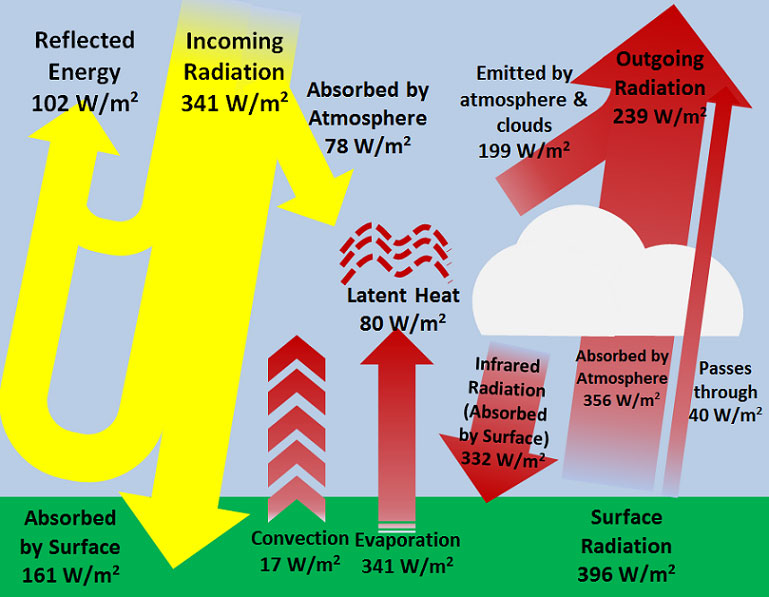The earth system gets its energy from our star, the Sun. Radiation from the Sun carries visible light as well as heat to the earth. Most of the solar energy is absorbed by earth’s surface while most of the incoming heat is radiated back to the space by atmosphere. However, earth, as a whole, neither accumulates nor loses heat. It maintains its temperature. But, that does not mean every part of earth loses as much heat as it gains from insolation. The tropical latitudes get much more insolation as compared to the Polar Regions. Further, Polar Regions reflect more heat in the form of terrestrial radiation as compared to the tropical region. So, there is a net gain of heat in the tropical region of the earth while there is a net loss of heat in the Polar Regions.
Note: Meaning of insolation is the amount of solar radiation reaching a given area on earth.
Meaning of Albedo: It is a measure of reflectiveness or how much energy that hits a surface is reflected without being absorbed.
Earth’s heat budget is maintained by two large, opposing energy fluxes between the atmosphere and the ground (right)—the greenhouse effect.
Earth’s heat balance is primarily maintained by transferring excess heat from the equatorial region towards the polar regions. This transfer happens through atmospheric and oceanic circulations.
Components of Heat Budget
Heat Budget can be said to have two main components i.e. incoming shortwave solar radiations and outgoing long-wave terrestrial radiations.
1. Incoming Shortwave Solar Radiations
Energy coming from the sun is called solar radiation. The sun emits shortwaves like x-rays, invisible UV rays and visible infrared rays. The atmosphere is not heated up by these shortwave radiations. These shortwaves from the sun are electromagnetic waves. The sun emits shortwaves because it is very hot and has more energy to give off.
2. Outgoing Long-wave Terrestrial Radiations
Earth’s surface receives solar energy from the shortwaves and re-emits in the form of long-wave radiations. These long-wave radiations are absorbed by the atmosphere and it gets warmed up. The earth emits long-wave radiations because it is cool and has lesser energy available to give off.
Earth’s Heat Budget
The total incoming solar radiation is considered to be 100 percent. And, the distribution and re-distribution of this 100% energy is the heat budget of the Earth. This balance in incoming and outgoing radiations prevents the earth from being excessively cold or excessively hot and the earth maintains the average temperature around 15 degrees centigrade. However, several different factors today are disturbing this balance and causing global warming i.e. overall increase in earth’s temperature.
Ideally, out of 100 units of solar radiation 17 units are reflected back to space by the clouds. 8 units are scattered into space by the air particles. 6 units are reflected off by the bright surfaces such as deserts and snow covers. The remaining 69 units of energy heat up the earth and its atmosphere. 19 units out of these 69 units are trapped by water vapor, dust particles and the ozone which heats up the atmosphere. Clouds absorb 4 units and the rest 46 units reach directly to the earth’s surface. Out of these 46 units received by the earth’s surface, 9 units are directly released into space through long-waves. 6 units of long-wave are absorbed by the clouds, ozone, water vapor and carbon dioxide.

Heat Surplus Region
The region roughly between 35 degrees north and 35 degrees south is called the heat surplus region. The incoming insolation in this area far exceeds the outgoing terrestrial radiation. The Equator receives approximately 275 joules insolation while the terrestrial radiation in heat surplus regions is around 200 joules. The amount of insolation decreases as one moves towards the pole and at the same time terrestrial radiation gradually increases.
Heat Deficit Region
The areas between 35 degrees north to the North Pole and 35 degrees south to the South Pole are the heat deficit regions of the earth. The outgoing terrestrial radiation in these areas exceeds the incoming solar radiation. The poles receive around 50 joules of solar radiation while the terrestrial radiation at the poles is around 120 joules. This wide gap between the insolation and terrestrial radiation makes the Polar Regions an energy deficit region.
Latitudinal Heat Balance
The difference in reflectiveness and insolation at different latitudes causes the net heat imbalance throughout the earth. Latitudinal Heat Balance is the process of redistribution and balancing of energy between heat surplus region and heat deficit regions of the earth. The heat is transferred from the heat surplus region or the lower latitudes to the heat deficit region or the higher latitudes through atmospheric and oceanic circulations. If the heat imbalances between different latitudes would not have been nullified by the atmospheric and oceanic circulations then the lower latitudes would get hotter and hotter while the higher latitudes would get colder and colder.
Use the citation below to add this article to your bibliography
"Heat Budget of Earth and Oceans: Variation with Latitude." Dashamlav.com. Web. 13 June 2025. <https://dashamlav.com/heat-budget-balance-maintenance/>
Dashamlav.com, "Heat Budget of Earth and Oceans: Variation with Latitude." Accessed 13 June 2025. https://dashamlav.com/heat-budget-balance-maintenance/
"Heat Budget of Earth and Oceans: Variation with Latitude." (n.d.). Dashamlav.com. Retrieved 13 June 2025 from https://dashamlav.com/heat-budget-balance-maintenance/
